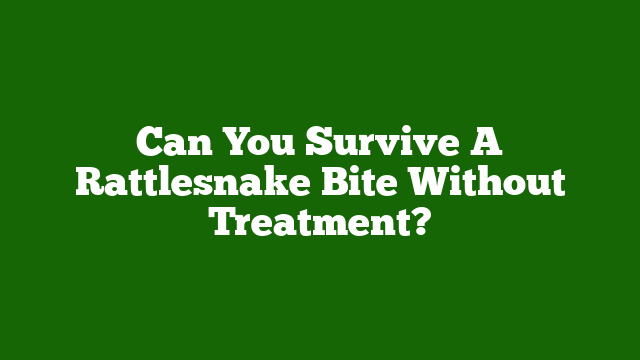Last Updated on June 12, 2023 by Umar
Rattlesnake bites are a serious concern for those venturing into the wilderness or living in areas where these venomous creatures reside.
The question of whether one can survive a rattlesnake bite without treatment is a complex one, with various factors at play.
In this comprehensive guide, we will explore personal experiences, research, and statistics to provide a detailed understanding of the potential outcomes of a rattlesnake bite without treatment.
Personal Experiences
While there are limited sources available for personal stories of rattlesnake bite survival without treatment, it is important to note that each individual’s experience can vary greatly.
Factors such as the location of the bite, the amount of venom injected, and the person’s overall health can all influence the outcome.
Research and Statistics
According to a source from Forest Wildlife
, it is technically possible to survive a rattlesnake bite without treatment.
However, the individual will almost certainly experience major complications and potentially life-threatening symptoms.Rattlesnake venom contains a complex mixture of proteins, enzymes, and other compounds that can cause severe tissue damage, blood clotting disorders, and even organ failure.
Without prompt medical intervention, the chances of survival decrease significantly.
The Importance of Seeking Treatment
While it may be possible for some individuals to survive a rattlesnake bite without treatment, the risks and potential complications are far too great to ignore.
Seeking immediate medical attention is crucial for increasing the chances of survival and minimizing the long-term effects of the venom.If you or someone you know is bitten by a rattlesnake, it is essential to take the following steps:
- Keep the affected limb immobilized and at a level below the heart to reduce the spread of venom.
- Remove any tight clothing or jewelry near the bite site to allow for swelling.
- Avoid attempting to suck out the venom or applying ice, as these methods can cause more harm than good.
- Seek professional medical help as soon as possible.
Conclusion
In conclusion, while it may be technically possible to survive a rattlesnake bite without treatment, the risks and potential complications make it an extremely dangerous and ill-advised course of action.
The best course of action is to seek immediate medical attention and follow the recommended guidelines for managing a rattlesnake bite.
By doing so, you can significantly increase your chances of survival and minimize the long-term effects of the venom.

